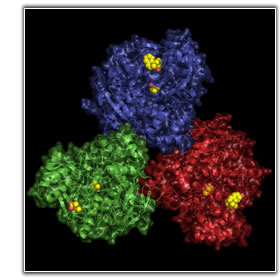
 Researchers in the Redinbo laboratory have examined both the recognition of drugs and xenobiotics by receptors like PXR, and the enzymes that break down potentially dangerous exogenous and endogenous compounds.
Researchers in the Redinbo laboratory have examined both the recognition of drugs and xenobiotics by receptors like PXR, and the enzymes that break down potentially dangerous exogenous and endogenous compounds.
We elucidated structures of the drug-metabolizing mammalian carboxylesterases as well as the sugar-conjugating UDP glucuronosyltransferases that facilitate drug elimination from key tissues.
In addition, we are investigating enzymes essential for chemotherapeutic activation and elimination in humans, with the goal of improving drug tolerance and efficacy in cancer patients.
Our group has studied enzymes from a range of systems, including protective human xenobiotic metabolizing proteins.
Sample publications include:
Miley, M.J., Zielinska, A.K., Keenan, J.E., Bratton, S.M., Radominska-Pandya, A., and Redinbo, M.R. (2007).
Crystal structure of the cofactor-binding domain of the human phase II drug-metabolism enzyme UDP-glucuronosyltransferase 2B7.
Journal of Molecular Biology, 369, 498-511.
Bencharit, S., Morton, C.L., Xue, Y., Potter, P.M. and Redinbo, M.R. (2003).
Structural basis of heroin and cocaine metabolism by a promiscuous human drug-processing enzyme.
Nature Structural Biology, 10, 349-356.
Bencharit, S., Morton, C.L., Howard-Williams, E.L., Danks, M.K., Potter, P.M., and Redinbo, M.R. (2002).
Structural insights into CPT-11 activation by mammalian carboxylesterases.
Nature Structural Biology, 9, 337-342.